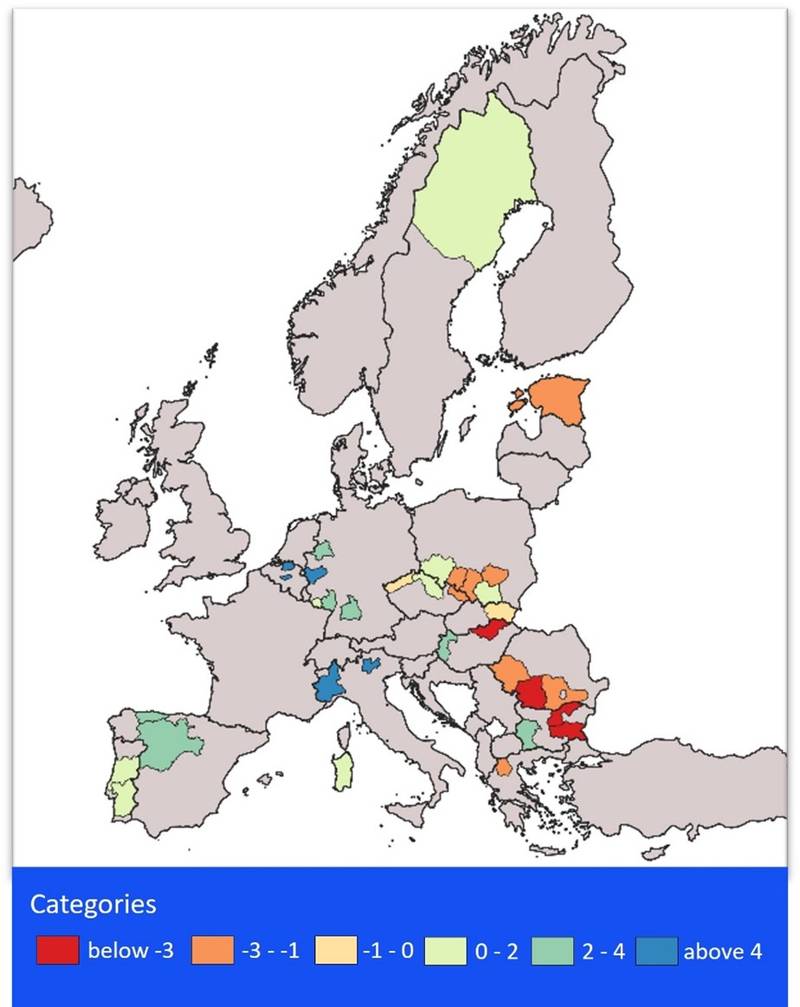31. August 2023Downscaling or upskilling? Socio-economic challenges in the green transition to climate-neutrality
Achieving climate neutrality by 2050, as announced in the EU Green Deal, will be particularly challenging for carbon-intensive regions with energy intensive industries such as coal mining, basic chemicals or steel and cement production. At the same time, the economic, social and territorial cohesion should not be put at risk so that ‘no person or place is left behind’.
Carbon-intensive regions and net migration rates, average 2000-2018 in % of population per 1000 inhabitants

Carbon intensive regions in Western EU countries including Sweden, tend to feature inward migration, while the majority of the respective regions in Central and Eastern Europe face outward migration. Source: Eurostat, own calculations – Map: wiiw.
Labour market, social situation and out-migration
The policy brief examines how the green transition will affect the labour market, but especially the social situation in the most exposed regions, focusing on out-migration from these areas. Questions that arise in this context are the following: how does the general economic and social situation differ between carbon intensive and non-carbon intensive regions? What role does (out)migration play? Based on the results the policy brief provides recommendations for the transition to climate neutrality.
Carbon intensive regions are lagging behind in economic….
Results of the descriptive and econometric analyses reveal that carbon-intensive regions, particularly in Central and Eastern Europe – where almost 60% of these regions are located – are on average characterized by poorer economic and social conditions than non-carbon-intensive regions. They do not only face a potential decline in employment, but also out-migration that could diminish their prospects for longer-term economic prosperity: carbon-intensive regions with out-migration show a lower GDP per capita than non-carbon intensive regions with out-migration, a lower proportion of highly educated people, an extremely low participation rate in life-long learning and a higher share of early school leavers.
… and social development
Based on the Social Progress Index (SPI) the analysis shows that the social situation is generally worse in the carbon intensive regions than in non-carbon intensive regions. Especially regions with out-migration are lagging behind in a number of areas of social infrastructure, services and outcomes: e.g., health, (early) education, but also housing and other areas of well-being. Results of an econometric exercise reveal that welfare regimes of EU countries matter for outcomes. Social-democratic welfare regimes, characterized by universal social provisions and high levels of decommodification, outperformed other types of welfare systems on a wide range of social indicators. By contrast, post-communist and South-European countries had the worst social situation, whereas the liberal and conservative welfare regimes took the middle position.
Out-migration jeopardizes carbon-intensive regions’ future social infrastructure
What does out-migration mean for the future prospects of these regions? What social consequences are to be expected? Carbon-intensive regions with out-migration have fewer chances to provide their residents with sound and equal economic opportunities, social services and levels of well-being compared to non-carbon-intensive ones. This particularly affects rural areas where the population is at higher risk of poverty than in urban areas due to poorer access to basic infrastructure and services. If carbon-intensive regions encounter the problem of negative net migration, their social development is very likely to take a sharp negative turn.
Highly skilled tend to leave carbon-intensive regions
Carbon-intensive regions are in particular unattractive for highly educated workers, and the low level of their GDP per capita is associated with higher out-migration from these regions. Outflows of highly educated and young individuals can further result in important fiscal consequences for regions, e.g. the lack of revenues that are required to afford public goods and services. Even if employment growth exists in carbon-intensive regions, it appears that in addition other factors like ‘human capital’ related and demographic aspects, network effects, social infrastructure, and the situation of well-being in general are relevant to attract (skilled) workers from other regions.
Recommendations
In order to foster the socio-economic revival of carbon intensive regions, job-creating investments are not sufficient. Rather, they need to be accompanied by a package of measures to improve the overall attractiveness of those regions.
- Apart from job-creating investments, there is a need for investments in health, education and training infrastructure, as well as in other areas that promote the well-being of the resident population and also attract workers from other regions.
- In view of the looming labour shortages, carbon intensive regions should promote reskilling and upskilling of all workers and strive for keeping them in the region in times of restructuring.
- Also, ‘traditional’ infrastructure investment is of importance, since not only connecting the regions to main European transport networks, but also connecting the hinterland within the regions, is one of the factors that policy may look into.
Besides, these investments would deliver the promise of the EU laid down in the Social Pillar, i.e., to offer more equal opportunities to its citizens throughout the European Union, no matter in which region they live.
Overall, long-term financial support would be appropriate to upgrade the carbon-intensive regions (especially in the Central and Eastern European EU countries) and make them more attractive places to live and work. A first step in this direction has been taken by the establishment of the Just Transition Fund (JTF) set up by the EU. The fund was set up to mitigate the socio-economic costs triggered by the climate transition and to support the economic diversification and reconversion of the territories most negatively impacted by the transition.
Download policy brief here.
Authors
Sebastian Leitner
Senior Economist
The Vienna Institute for International Economic Studies (wiiw)
Hermine Vidovic
Senior Research Associate
The Vienna Institute for International Economic Studies (wiiw)